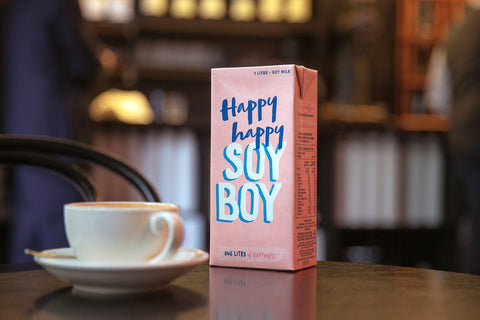Join us for a conversation with Lloyd Andre Smith, founder of Happy happy Soy Boy, a proud partner of Standart Issue 28.
Can you tell us a little more about the 210 MW Musi Hydro Power Plant Project underway in the Bengkulu region of Sumatra? How did Happy happy come to be involved?
The Musi River Hydro Power Plant Project was commissioned in 2006. Sumatra, Indonesia’s largest island, is home to fertile soil that is ideal for growing commodities such as coffee. Despite this, new economic opportunities are limited by rudimentary infrastructure and poor electricity access – and growing energy demands threaten Sumatra’s unique natural ecosystems.

As part of one of the most prominent coffee-producing regions in the world, Sumatra is an area relied heavily upon by our industry. I have seen firsthand the impacts of climate change on coffee-growing communities, such as rising temperatures and changing seasonality, after spending time exporting coffee in Sumatra in 2015. For this reason we knew the Musi River Hydro Power Plant was a project we wanted to support.
By harnessing the kinetic energy of the powerful running water, the Musi River hydroplane has a total installed capacity of 210 MW and delivers over 765,000 MWh to Sumatra’s grid every year – that’s enough to meet the demands of over 700,000 Indonesians on average each year. This project addresses issues in rural Sumatra such as poor electricity access and the lack of quality employment opportunities – as well as fostering sustainable economic development.

The Musi River Hydro plant has created quality jobs and upskilling opportunities for locals in what has been traditionally a farming community. A portion of project revenue has been reinvested in the local community to build an orphanage, and construct new roads, bridges, and a traditional marketplace – giving the local farmers better access to their rice paddies and the opportunity to pursue additional income. A reforestation program has also been established in the surrounding catchment area to safeguard the natural landscape.
We contribute to this product by purchasing carbon credits through Pangolin Associates, an Australian Climate Active registered consultant.
In addition to your m*lk products, you also offer hot chocolate and matcha. Can you say a few words about what cafes can expect from these offerings?
We are incredibly excited about all of the new products we’ve added to our plant-based portfolio this year.
Happy happy is proud to partner with Australian green tea farmer, Akio Onozawa, to bring you Happy happy Mumma Matcha. This special product is grown 150 metres above sea level on a single estate in Mangrove Mountain, New South Wales. The most delicate Yabukita leaves from the first harvest of the year are picked and finely ground to produce our organic matcha powder. With no added sugar, you can expect a subtle flavour profile with balanced astringency.

Crafted using West African cacao beans, Happy happy Hot Chocolate is gluten-free as well as vegan friendly. Our chocolate powder boasts a rich and creamy mouthfeel for a smoother-tasting hot chocolate.
'The product I had in mind had to perform like dairy milk when added to espresso, without compromising on taste or nutrition, which is why we created the nutritionally comparable Happy happy Soy Boy.'
For maximum happiness, we recommend pairing our matcha and hot chocolate with your choice of one of our plant-based milks: Happy happy Soy Boy, Happy happy Almond Daddy or Happy happy Oat Oat Oat.
Making great products can’t be easy or simple. How much R&D typically goes into one of your offerings ahead of its release to market?
Happy happy Soy Boy first landed on the Australian café scene in late 2018 following a rigorous development process. I come from a coffee background, and as a reformed dairy drinker, I had the desire to create a low-impact, sustainable plant-based milk for the café market.
The product I had in mind had to perform like dairy milk when added to espresso, without compromising on taste or nutrition, which is why we created the nutritionally comparable Happy happy Soy Boy.

This was no easy feat as we decided to use only five natural ingredients and to keep our product free from stabilisers and emulsifiers.
One of the main challenges arose as soy milk is so high in protein. Proteins are difficult to make work well with high-acidity espresso, but we were able to achieve the right formulation through meticulous refinement of our production method.
From delays and expenses in sourcing high-quality raw materials to ensuring a balanced taste and texture when mixed with the acidity of espresso, the development of Happy happy Soy Boy took almost four years. Following our soy milk’s incredible feedback and success, we got to work expanding our range, now offering almond milk, oat milk, matcha powder and hot chocolate powder.
'Our mission is to make plant-based foods and beverages tastier, fun, more mainstream and better for the environment, than the products of the generation before us.'
Baristas, café owners and customers can rest assured that each of our new premium products is carefully crafted with the specialty coffee, matcha or hot chocolate drinker in mind - plus, they’re happier for you and happier for the environment.
This interview was published in proud partnership with Happy happy Soy Boy.



